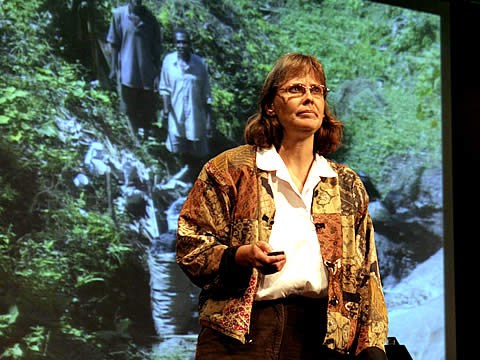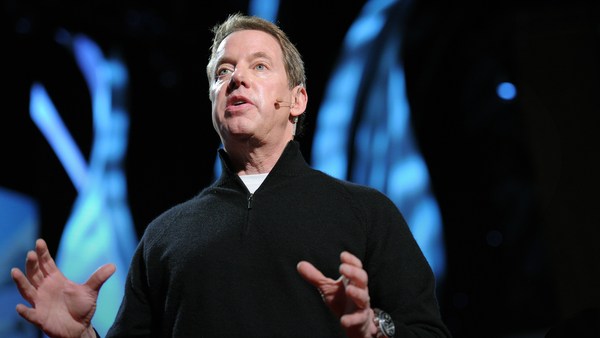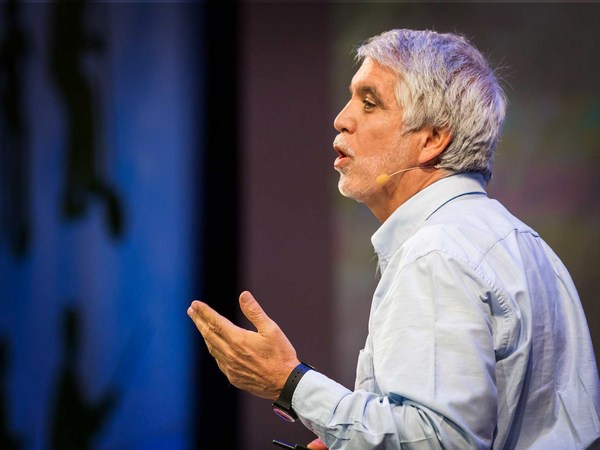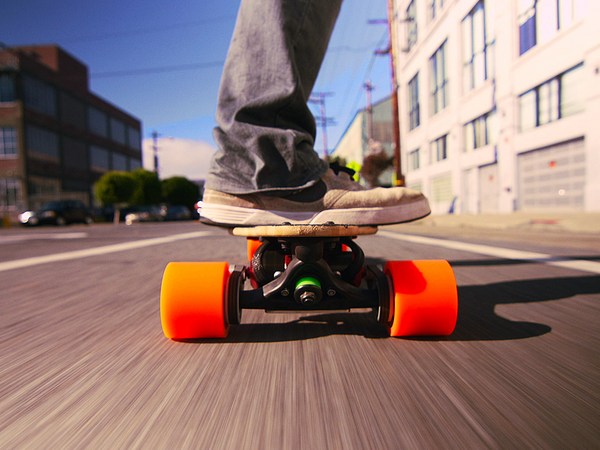As you pointed out, every time you come here, you learn something. This morning, the world's experts from I guess three or four different companies on building seats, I think concluded that ultimately, the solution is, people shouldn't sit down. I could have told them that. (Laughter) Yesterday, the automotive guys gave us some new insights. They pointed out that, I believe it was between 30 and 50 years from today, they will be steering cars by wire, without all that mechanical stuff. (Laughter) That's reassuring. (Applause) They then pointed out that there'd be, sort of, the other controls by wire, to get rid of all that mechanical stuff. That's pretty good, but why not get rid of the wires? Then you don't need anything to control the car, except thinking about it. I would love to talk about the technology, and sometime, in what's past the 15 minutes, I'll be happy to talk to all the techno-geeks around here about what's in here. But if I had one thing to say about this, before we get to first, it would be that from the time we started building this, the big idea wasn't the technology. It really was a big idea in technology when we started applying it in the iBOT for the disabled community. The big idea here is, I think, a new piece of a solution to a fairly big problem in transportation. And maybe to put that in perspective: there's so much data on this, I'll be happy to give it to you in different forms. You never know what strikes the fancy of whom, but everybody is perfectly willing to believe the car changed the world. And Henry Ford, just about 100 years ago, started cranking out Model Ts. What I don't think most people think about is the context of how technology is applied. For instance, in that time, 91 percent of America lived either on farms or in small towns. So, the car -- the horseless carriage that replaced the horse and carriage -- was a big deal; it went twice as fast as a horse and carriage. It was half as long. And it was an environmental improvement, because, for instance, in 1903 they outlawed horses and buggies in downtown Manhattan, because you can imagine what the roads look like when you have a million horses, and a million of them urinating and doing other things, and the typhoid and other problems created were almost unimaginable. So the car was the clean environmental alternative to a horse and buggy. It also was a way for people to get from their farm to a farm, or their farm to a town, or from a town to a city. It all made sense, with 91 percent of the people living there. By the 1950s, we started connecting all the towns together with what a lot of people claim is the eighth wonder of the world, the highway system. And it is certainly a wonder. And by the way, as I take shots at old technologies, I want to assure everybody, and particularly the automotive industry -- who's been very supportive of us -- that I don't think this in any way competes with airplanes, or cars. But think about where the world is today. 50 percent of the global population now lives in cities. That's 3.2 billion people. We've solved all the transportation problems that have changed the world to get it to where we are today. 500 years ago, sailing ships started getting reliable enough; we found a new continent. 150 years ago, locomotives got efficient enough, steam power, that we turned the continent into a country. Over the last hundred years, we started building cars, and then over the 50 years we've connected every city to every other city in an extraordinarily efficient way, and we have a very high standard of living as a consequence of that. But during that entire process, more and more people have been born, and more and more people are moving to cities. China alone is going to move four to six hundred million people into cities in the next decade and a half. And so, nobody, I think, would argue that airplanes, in the last 50 years, have turned the continent and the country now into a neighborhood. And if you just look at how technology has been applied, we've solved all the long-range, high-speed, high-volume, large-weight problems of moving things around. Nobody would want to give them up. And I certainly wouldn't want to give up my airplane, or my helicopter, or my Humvee, or my Porsche. I love them all. I don't keep any of them in my living room. The fact is, the last mile is the problem, and half the world now lives in dense cities. And people spend, depending on who they are, between 90 and 95 percent of their energy getting around on foot. I think there's -- I don't know what data would impress you, but how about, 43 percent of the refined fuel produced in the world is consumed by cars in metropolitan areas in the United States. Three million people die every year in cities due to bad air, and almost all particulate pollution on this planet is produced by transportation devices, particularly sitting in cities. And again, I say that not to attack any industry, I think -- I really do -- I love my airplane, and cars on highways moving 60 miles an hour are extraordinarily efficient, both from an engineering point of view, an energy consumption point of view, and a utility point of view. And we all love our cars, and I do. The problem is, you get into the city and you want to go four blocks, it's neither fun nor efficient nor productive. It's not sustainable. If -- in China, in the year 1998, 417 million people used bicycles; 1.7 million people used cars. If five percent of that population became, quote, middle class, and wanted to go the way we've gone in the last hundred years at the same time that 50 percent of their population are moving into cities of the size and density of Manhattan, every six weeks -- it isn't sustainable environmentally; it isn't sustainable economically -- there just ain't enough oil -- and it's not sustainable politically. I mean, what are we fighting over right now? We can make it complicated, but what's the world fighting over right now? So it seemed to me that somebody had to work on that last mile, and it was dumb luck. We were working on iBOTs, but once we made this, we instantly decided it could be a great alternative to jet skis. You don't need the water. Or snowmobiles. You don't need the snow. Or skiing. It's just fun, and people love to move around doing fun things. And every one of those industries, by the way -- just golf carts alone is a multi-billion-dollar industry. But rather than go license this off, which is what we normally do, it seemed to me that if we put all our effort not into the technology, but into an understanding of a world that's solved all its other problems, but has somehow come to accept that cities -- which, right back from ancient Greece on, were meant to walk around, cities that were architected and built for people -- now have a footprint that, while we've solved every other transportation problem -- and it's like Moore's law. I mean, look at the time it took to cross a continent in a Conestoga wagon, then on a railroad, then an airplane. Every other form of transportation's been improved. In 5,000 years, we've gone backwards in getting around cities. They've gotten bigger; they're spread out. The most expensive real estate on this planet in every city -- Wilshire Boulevard, or Fifth Avenue, or Tokyo, or Paris -- the most expensive real estate is their downtowns. 65 percent of the landmass of our cities are parked cars. The 20 largest cities in the world. So you wonder, what if cities could give to their pedestrians what we take for granted as we now go between cities? What if you could make them fun, attractive, clean, environmentally friendly? What if it would make it a little bit more palatable to have access via this, as that last link to mass transit, to get out to your cars so we can all live in the suburbs and use our cars the way we want, and then have our cities energized again? We thought it would be really neat to do that, and one of the problems we really were worried about is: how do we get legal on the sidewalk? Because technically I've got motors; I've got wheels -- I'm a motor vehicle. I don't look like a motor vehicle. I have the same footprint as a pedestrian; I have the same unique capability to deal with other pedestrians in a crowded space. I took this down to Ground Zero, and knocked my way through crowds for an hour. I'm a pedestrian. But the law typically lags technology by a generation or two, and if we get told we don't belong on the sidewalk, we have two choices. We're a recreational vehicle that doesn't really matter, and I don't spend my time doing that kind of stuff. Or maybe we should be out in the street in front of a Greyhound bus or a vehicle. We've been so concerned about that, we went to the Postmaster General of the United States, as the first person we ever showed on the outside, and said, "Put your people on it. Everybody trusts their postman. And they belong on the sidewalks, and they'll use it seriously." He agreed. We went to a number of police departments that want their police officers back in the neighborhood on the beat, carrying 70 pounds of stuff. They love it. And I can't believe a policeman is going to give themselves a ticket. (Laughter) So we've been working really, really hard, but we knew that the technology would not be as hard to develop as an attitude about what's important, and how to apply the technology. We went out and we found some visionary people with enough money to let us design and build these things, and in hopefully enough time to get them accepted. So, I'm happy, really, I am happy to talk about this technology as much as you want. And yes, it's really fun, and yes, you should all go out and try it. But if I could ask you to do one thing, it's not to think about it as a piece of technology, but just imagine that, although we all understand somehow that it's reasonable that we use our 4,000-pound machine, which can go 60 miles an hour, that can bring you everywhere you want to go, and somehow it's also what we used for the last mile, and it's broken, and it doesn't work. One of the more exciting things that occurred to us about why it might get accepted, happened out here in California. A few weeks ago, after we launched it, we were here with a news crew on Venice Beach, zipping up and back, and he's marveling at the technology, and meanwhile bicycles are zipping by, and skateboarders are zipping by, and a little old lady -- I mean, if you looked in the dictionary, a little old lady -- came by me -- and now that I'm on this, I'm the height of a normal adult now -- and she just stops, and the camera is there, and she looks up at me and says, "Can I try that?" And what was I -- you know, how are you going to say anything? And so I said, "Sure." So I get off, and she gets on, and with a little bit of the usual, ah, then she turns around, and she goes about 20 feet, and she turns back around, and she's all smiles. And she comes back to me and she stops, and she says, "Finally, they made something for us." And the camera is looking down at her. I'm thinking, "Wow, that was great -- (Laughter) -- please lady, don't say another word." (Laughter) And the camera is down at her, and this guy has to put the microphone in her face, said, "What do you mean by that?" And I figured, "It's all over now," and she looks up and she says, "Well," she's still watching these guys go; she says, "I can't ride a bike," no, she says, "I can't use a skateboard, and I've never used roller blades," she knew them by name; she says, "And it's been 50 years since I rode a bicycle." Then she looks up, she's looking up, and she says, "And I'm 81 years old, and I don't drive a car anymore. I still have to get to the store, and I can't carry a lot of things." And it suddenly occurred to me, that among my many fears, were not just that the bureaucracy and the regulators and the legislators might not get it -- it was that, fundamentally, you believe there's pressure among the people not to invade the most precious little bit of space left, the sidewalks in these cities. When you look at the 36 inches of legal requirement for sidewalk, then the eight foot for the parked car, then the three lanes, and then the other eight feet -- it's -- that little piece is all that's there. But she looks up and says this, and it occurs to me, well, kids aren't going to mind these things, and they don't vote, and business people and then young adults aren't going to mind these things -- they're pretty cool -- so I guess subliminally I was worried that it's the older population that's going to worry. So, having seen this, and having worried about it for eight years, the first thing I do is pick up my phone and ask our marketing and regulatory guys, call AARP, get an appointment right away. We've got to show them this thing. And they took it to Washington; they showed them; and they're going to be involved now, watching how these things get absorbed in a number of cities, like Atlanta, where we're doing trials to see if it really can, in fact, help re-energize their downtown. (Applause) The bottom line is, whether you believe the United Nations, or any of the other think tanks -- in the next 20 years, all human population growth on this planet will be in cities. In Asia alone, it will be over a billion people. They learned to start with cell phones. They didn't have to take the 100-year trip we took. They start at the top of the technology food chain. We've got to start building cities and human environments where a 150-pound person can go a couple of miles in a dense, rich, green-space environment, without being in a 4,000-pound machine to do it. Cars were not meant for parallel parking; they're wonderful machines to go between cities, but just think about it: we've solved all the long-range, high-speed problems. The Greeks went from the theater of Dionysus to the Parthenon in their sandals. You do it in your sneakers. Not much has changed. If this thing goes only three times as fast as walking -- three times -- a 30-minute walk becomes 10 minutes. Your choice, when living in a city, if it's now 10 minutes -- because at 30 minutes you want an alternative, whether it's a bus, a train -- we've got to build an infrastructure -- a light rail -- or you're going to keep parking those cars. But if you could put a pin in most cities, and imagine how far you could, if you had the time, walk in one half-hour, it's the city. If you could make it fun, and make it eight or 10 minutes, you can't find your car, un-park your car, move your car, re-park your car and go somewhere; you can't get to a cab or a subway. We could change the way people allocate their resources, the way this planet uses its energy, make it more fun. And we're hoping to some extent history will say we were right. That's Segway. This is a Stirling cycle engine; this had been confused by a lot of things we're doing. This little beast, right now, is producing a few hundred watts of electricity. Yes, it could be attached to this, and yes, on a kilogram of propane, you could drive from New York to Boston if you so choose. Perhaps more interesting about this little engine is it'll burn any fuel, because some of you might be skeptical about the capability of this to have an impact, where most of the world you can't simply plug into your 120-volt outlet. We've been working on this, actually, as an alternative energy source, starting way back with Johnson & Johnson, to run an iBOT, because the best batteries you could get -- 10 watt-hours per kilogram in lead, 20 watt-hours per kilogram nickel-cadmium, 40 watt-hours per kilogram in nickel-metal hydride, 60 watt-hours per kilogram in lithium, 8,750 watt-hours of energy in every kilogram of propane or gasoline -- which is why nobody drives electric cars. But, in any event, if you can burn it with the same efficiency -- because it's external combustion -- as your kitchen stove, if you can burn any fuel, it turns out to be pretty neat. It makes just enough electricity to, for instance, do this, which at night is enough electricity, in the rest of the world, as Mr. Holly -- Dr. Holly -- pointed out, can run computers and a light bulb. But more interestingly, the thermodynamics of this say, you're never going to get more than 20 percent efficiency. It doesn't matter much -- it says if you get 200 watts of electricity, you'll get 700 or 800 watts of heat. If you wanted to boil water and re-condense it at a rate of 10 gallons an hour, it takes about 25, a little over 25.3 kilowatt -- 25,000 watts of continuous power -- to do it. That's so much energy, you couldn't afford to desalinate or clean water in this country that way. Certainly, in the rest of the world, your choice is to devastate the place, turning everything that will burn into heat, or drink the water that's available. The number one cause of death on this planet among humans is bad water. Depending on whose numbers you believe, it's between 60 and 85,000 people per day. We don't need sophisticated heart transplants around the world. We need water. And women shouldn't have to spend four hours a day looking for it, or watching their kids die. We figured out how to put a vapor-compression distiller on this thing, with a counter-flow heat exchanger to take the waste heat, then using a little bit of the electricity control that process, and for 450 watts, which is a little more than half of its waste heat, it will make 10 gallons an hour of distilled water from anything that comes into it to cool it. So if we put this box on here in a few years, could we have a solution to transportation, electricity, and communication, and maybe drinkable water in a sustainable package that weighs 60 pounds? I don't know, but we'll try it. I better shut up. (Applause)





